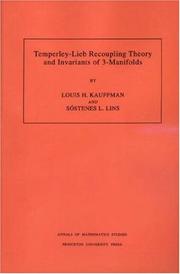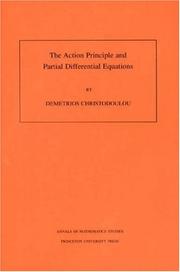| Listing 1 - 5 of 5 |
Sort by
|
Book
ISBN: 1400852749 Year: 2014 Publisher: Princeton, New Jersey ; Oxfordshire, England : Princeton University Press,
Abstract | Keywords | Export | Availability | Bookmark
 Loading...
Loading...Choose an application
- Reference Manager
- EndNote
- RefWorks (Direct export to RefWorks)
Quaternions are a number system that has become increasingly useful for representing the rotations of objects in three-dimensional space and has important applications in theoretical and applied mathematics, physics, computer science, and engineering. This is the first book to provide a systematic, accessible, and self-contained exposition of quaternion linear algebra. It features previously unpublished research results with complete proofs and many open problems at various levels, as well as more than 200 exercises to facilitate use by students and instructors. Applications presented in the book include numerical ranges, invariant semidefinite subspaces, differential equations with symmetries, and matrix equations. Designed for researchers and students across a variety of disciplines, the book can be read by anyone with a background in linear algebra, rudimentary complex analysis, and some multivariable calculus. Instructors will find it useful as a complementary text for undergraduate linear algebra courses or as a basis for a graduate course in linear algebra. The open problems can serve as research projects for undergraduates, topics for graduate students, or problems to be tackled by professional research mathematicians. The book is also an invaluable reference tool for researchers in fields where techniques based on quaternion analysis are used.
Algebras, Linear --- Quaternions --- Algebra, Universal --- Algebraic fields --- Curves --- Surfaces --- Numbers, Complex --- Vector analysis --- Linear algebra --- Generalized spaces --- Mathematical analysis --- Calculus of operations --- Line geometry --- Topology --- Cholesky factorization. --- Hamiltonian matrices. --- Jordan canonical form. --- Jordan form. --- Kronecker canonical form. --- Kronecker form. --- Kronecker forms. --- Schur triangularization theorem. --- Smith form. --- Sylvester equation. --- algebraic Riccati equations. --- antiautomorphisms. --- automorphisms. --- bilateral quadratic equations. --- boundedness. --- canonical forms. --- complex hermitian matrices. --- complex matric pencils. --- complex matrices. --- complex matrix polynomials. --- congruence. --- conjugation. --- conventions. --- determinants. --- diagonal form. --- diagonalizability. --- differential equations. --- dissipative matrices. --- eigenvalues. --- eigenvectors. --- equivalence. --- expansive matrices. --- hermitian inner product. --- hermitian matrices. --- hermitian matrix pencils. --- hermitian pencils. --- indefinite inner products. --- inertia theorems. --- invariant Langragian subspaces. --- invariant Langrangian subspaces. --- invariant neutral subspaces. --- invariant semidefinite subspaces. --- invariant subspaces. --- involutions. --- linear quadratic regulators. --- matrix algebra. --- matrix decompositions. --- matrix equations. --- matrix pencils. --- matrix polynomials. --- maximal invariant semidefinite subspaces. --- metric space. --- mixed matrix pencils. --- mixed pencils. --- mixed quaternion matrix pencils. --- neutral subspaces. --- nondegenerate. --- nonstandard involution. --- nonstandard involutions. --- nonuniqueness. --- notations. --- numerical cones. --- numerical ranges. --- pencils. --- polynomial matrix equations. --- quadratic maps. --- quaternion algebra. --- quaternion coefficients. --- quaternion linear algebra. --- quaternion matrices. --- quaternion matrix pencils. --- quaternion subspaces. --- quaternions. --- real linear transformations. --- real matrices. --- real matrix pencils. --- real matrix polynomials. --- real symmetric matrices. --- root subspaces. --- scalar quaternions. --- semidefinite subspaces. --- skew-Hamiltonian matrices. --- skewhermitian inner product. --- skewhermitian matrices. --- skewhermitian pencils. --- skewsymmetric matrices. --- square-size quaternion matrices. --- standard matrices. --- symmetric matrices. --- symmetries. --- symmetry properties. --- unitary matrices. --- vector spaces.

ISBN: 0691112983 1400884330 9781400884339 9780691112985 Year: 2016 Publisher: Princeton University Press
Abstract | Keywords | Export | Availability | Bookmark
 Loading...
Loading...Choose an application
- Reference Manager
- EndNote
- RefWorks (Direct export to RefWorks)
Rabinowitz's classical global bifurcation theory, which concerns the study in-the-large of parameter-dependent families of nonlinear equations, uses topological methods that address the problem of continuous parameter dependence of solutions by showing that there are connected sets of solutions of global extent. Even when the operators are infinitely differentiable in all the variables and parameters, connectedness here cannot in general be replaced by path-connectedness. However, in the context of real-analyticity there is an alternative theory of global bifurcation due to Dancer, which offers a much stronger notion of parameter dependence. This book aims to develop from first principles Dancer's global bifurcation theory for one-parameter families of real-analytic operators in Banach spaces. It shows that there are globally defined continuous and locally real-analytic curves of solutions. In particular, in the real-analytic setting, local analysis can lead to global consequences--for example, as explained in detail here, those resulting from bifurcation from a simple eigenvalue. Included are accounts of analyticity and implicit function theorems in Banach spaces, classical results from the theory of finite-dimensional analytic varieties, and the links between these two and global existence theory. Laying the foundations for more extensive studies of real-analyticity in infinite-dimensional problems and illustrating the theory with examples, Analytic Theory of Global Bifurcation is intended for graduate students and researchers in pure and applied analysis.
Differential geometry. Global analysis --- Bifurcation theory. --- Differential equations, Nonlinear --- Stability --- Numerical solutions --- Addition. --- Algebraic equation. --- Analytic function. --- Analytic manifold. --- Atmospheric pressure. --- Banach space. --- Bernhard Riemann. --- Bifurcation diagram. --- Boundary value problem. --- Bounded operator. --- Bounded set (topological vector space). --- Boundedness. --- Canonical form. --- Cartesian coordinate system. --- Codimension. --- Compact operator. --- Complex analysis. --- Complex conjugate. --- Complex number. --- Connected space. --- Coordinate system. --- Corollary. --- Curvature. --- Derivative. --- Diagram (category theory). --- Differentiable function. --- Differentiable manifold. --- Dimension (vector space). --- Dimension. --- Direct sum. --- Eigenvalues and eigenvectors. --- Elliptic integral. --- Embedding. --- Equation. --- Euclidean division. --- Euler equations (fluid dynamics). --- Existential quantification. --- First principle. --- Fredholm operator. --- Froude number. --- Functional analysis. --- Hilbert space. --- Homeomorphism. --- Implicit function theorem. --- Integer. --- Linear algebra. --- Linear function. --- Linear independence. --- Linear map. --- Linear programming. --- Linear space (geometry). --- Linear subspace. --- Linearity. --- Linearization. --- Metric space. --- Morse theory. --- Multilinear form. --- N0. --- Natural number. --- Neumann series. --- Nonlinear functional analysis. --- Nonlinear system. --- Numerical analysis. --- Open mapping theorem (complex analysis). --- Operator (physics). --- Ordinary differential equation. --- Parameter. --- Parametrization. --- Partial differential equation. --- Permutation group. --- Permutation. --- Polynomial. --- Power series. --- Prime number. --- Proportionality (mathematics). --- Pseudo-differential operator. --- Puiseux series. --- Quantity. --- Real number. --- Resultant. --- Singularity theory. --- Skew-symmetric matrix. --- Smoothness. --- Solution set. --- Special case. --- Standard basis. --- Sturm–Liouville theory. --- Subset. --- Symmetric bilinear form. --- Symmetric group. --- Taylor series. --- Taylor's theorem. --- Theorem. --- Total derivative. --- Two-dimensional space. --- Union (set theory). --- Variable (mathematics). --- Vector space. --- Zero of a function.

ISBN: 0691036411 0691036403 1400882532 9780691036403 9780691036410 Year: 1994 Volume: 134 Publisher: Princeton (N.J.): Princeton university press,
Abstract | Keywords | Export | Availability | Bookmark
 Loading...
Loading...Choose an application
- Reference Manager
- EndNote
- RefWorks (Direct export to RefWorks)
This book offers a self-contained account of the 3-manifold invariants arising from the original Jones polynomial. These are the Witten-Reshetikhin-Turaev and the Turaev-Viro invariants. Starting from the Kauffman bracket model for the Jones polynomial and the diagrammatic Temperley-Lieb algebra, higher-order polynomial invariants of links are constructed and combined to form the 3-manifold invariants. The methods in this book are based on a recoupling theory for the Temperley-Lieb algebra. This recoupling theory is a q-deformation of the SU(2) spin networks of Roger Penrose. The recoupling theory is developed in a purely combinatorial and elementary manner. Calculations are based on a reformulation of the Kirillov-Reshetikhin shadow world, leading to expressions for all the invariants in terms of state summations on 2-cell complexes. Extensive tables of the invariants are included. Manifolds in these tables are recognized by surgery presentations and by means of 3-gems (graph encoded 3-manifolds) in an approach pioneered by Sostenes Lins. The appendices include information about gems, examples of distinct manifolds with the same invariants, and applications to the Turaev-Viro invariant and to the Crane-Yetter invariant of 4-manifolds.
Drie-menigvuldigheden (Topologie) --- Knopentheorie --- Knot theory --- Noeuds [Theorie des ] --- Three-manifolds (Topology) --- Trois-variétés (Topologie) --- Knot theory. --- Algebraic topology --- Invariants --- Mathematics --- Invariants (Mathematics) --- Invariants. --- 3-manifolds (Topology) --- Manifolds, Three dimensional (Topology) --- Three-dimensional manifolds (Topology) --- Low-dimensional topology --- Topological manifolds --- Knots (Topology) --- 3-manifold. --- Addition. --- Algorithm. --- Ambient isotopy. --- Axiom. --- Backslash. --- Barycentric subdivision. --- Bijection. --- Bipartite graph. --- Borromean rings. --- Boundary parallel. --- Bracket polynomial. --- Calculation. --- Canonical form. --- Cartesian product. --- Cobordism. --- Coefficient. --- Combination. --- Commutator. --- Complex conjugate. --- Computation. --- Connected component (graph theory). --- Connected sum. --- Cubic graph. --- Diagram (category theory). --- Dimension. --- Disjoint sets. --- Disjoint union. --- Elaboration. --- Embedding. --- Equation. --- Equivalence class. --- Explicit formula. --- Explicit formulae (L-function). --- Factorial. --- Fundamental group. --- Graph (discrete mathematics). --- Graph embedding. --- Handlebody. --- Homeomorphism. --- Homology (mathematics). --- Identity element. --- Intersection form (4-manifold). --- Inverse function. --- Jones polynomial. --- Kirby calculus. --- Line segment. --- Linear independence. --- Matching (graph theory). --- Mathematical physics. --- Mathematical proof. --- Mathematics. --- Maxima and minima. --- Monograph. --- Natural number. --- Network theory. --- Notation. --- Numerical analysis. --- Orientability. --- Orthogonality. --- Pairing. --- Pairwise. --- Parametrization. --- Parity (mathematics). --- Partition function (mathematics). --- Permutation. --- Poincaré conjecture. --- Polyhedron. --- Quantum group. --- Quantum invariant. --- Recoupling. --- Recursion. --- Reidemeister move. --- Result. --- Roger Penrose. --- Root of unity. --- Scientific notation. --- Sequence. --- Significant figures. --- Simultaneous equations. --- Smoothing. --- Special case. --- Sphere. --- Spin network. --- Summation. --- Symmetric group. --- Tetrahedron. --- The Geometry Center. --- Theorem. --- Theory. --- Three-dimensional space (mathematics). --- Time complexity. --- Tubular neighborhood. --- Two-dimensional space. --- Vector field. --- Vector space. --- Vertex (graph theory). --- Winding number. --- Writhe.

ISBN: 0691049572 0691049564 1400882680 Year: 2000 Volume: no. 146 Publisher: Princeton Princeton University press
Abstract | Keywords | Export | Availability | Bookmark
 Loading...
Loading...Choose an application
- Reference Manager
- EndNote
- RefWorks (Direct export to RefWorks)
This book introduces new methods in the theory of partial differential equations derivable from a Lagrangian. These methods constitute, in part, an extension to partial differential equations of the methods of symplectic geometry and Hamilton-Jacobi theory for Lagrangian systems of ordinary differential equations. A distinguishing characteristic of this approach is that one considers, at once, entire families of solutions of the Euler-Lagrange equations, rather than restricting attention to single solutions at a time. The second part of the book develops a general theory of integral identities, the theory of "compatible currents," which extends the work of E. Noether. Finally, the third part introduces a new general definition of hyperbolicity, based on a quadratic form associated with the Lagrangian, which overcomes the obstacles arising from singularities of the characteristic variety that were encountered in previous approaches. On the basis of the new definition, the domain-of-dependence theorem and stability properties of solutions are derived. Applications to continuum mechanics are discussed throughout the book. The last chapter is devoted to the electrodynamics of nonlinear continuous media.
Differentiaalvergelijkingen [Hyperbolische ] --- Differential equations [Hyperbolic] --- Equations différentielles hyperboliques --- Symplectic manifolds --- Differential equations, Hyperbolic. --- Symplectic manifolds. --- Variétés symplectiques --- Equations différentielles hyperboliques --- Variétés symplectiques --- Manifolds, Symplectic --- Geometry, Differential --- Manifolds (Mathematics) --- Hyperbolic differential equations --- Differential equations, Partial --- Action (physics). --- Boundary value problem. --- Canonical form. --- Causal structure. --- Classical mechanics. --- Complex analysis. --- Configuration space. --- Conservative vector field. --- Conserved current. --- Conserved quantity. --- Continuum mechanics. --- Derivative. --- Diffeomorphism. --- Differentiable manifold. --- Differential geometry. --- Dimension. --- Dimensional analysis. --- Dirichlet's principle. --- Einstein field equations. --- Electromagnetic field. --- Equation. --- Equations of motion. --- Equivalence class. --- Error term. --- Euclidean space. --- Euler system. --- Euler's equations (rigid body dynamics). --- Euler–Lagrange equation. --- Existence theorem. --- Existential quantification. --- Exponential map (Lie theory). --- Exponential map (Riemannian geometry). --- Exterior derivative. --- Fiber bundle. --- Foliation. --- Fritz John. --- General relativity. --- Hamiltonian mechanics. --- Hamilton–Jacobi equation. --- Harmonic map. --- Hessian matrix. --- Holomorphic function. --- Hyperbolic partial differential equation. --- Hyperplane. --- Hypersurface. --- Identity element. --- Iteration. --- Iterative method. --- Lagrangian (field theory). --- Lagrangian. --- Legendre transformation. --- Lie algebra. --- Linear approximation. --- Linear differential equation. --- Linear map. --- Linear span. --- Linearity. --- Linearization. --- Maximum principle. --- Maxwell's equations. --- Nonlinear system. --- Open set. --- Ordinary differential equation. --- Orthogonal complement. --- Parameter. --- Partial differential equation. --- Phase space. --- Pointwise. --- Poisson bracket. --- Polynomial. --- Principal part. --- Principle of least action. --- Probability. --- Pullback bundle. --- Pullback. --- Quadratic form. --- Quantity. --- Requirement. --- Riemannian manifold. --- Second derivative. --- Simultaneous equations. --- Special case. --- State function. --- Stokes' theorem. --- Subset. --- Surjective function. --- Symplectic geometry. --- Tangent bundle. --- Tangent vector. --- Theorem. --- Theoretical physics. --- Theory. --- Underdetermined system. --- Variable (mathematics). --- Vector bundle. --- Vector field. --- Vector space. --- Volume form. --- Zero of a function. --- Zero set.
Book
ISBN: 9781400858927 1400858925 Year: 2014 Publisher: Princeton Princeton University Press
Abstract | Keywords | Export | Availability | Bookmark
 Loading...
Loading...Choose an application
- Reference Manager
- EndNote
- RefWorks (Direct export to RefWorks)
This book develops arithmetic without the induction principle, working in theories that are interpretable in Raphael Robinson's theory Q. Certain inductive formulas, the bounded ones, are interpretable in Q. A mathematically strong, but logically very weak, predicative arithmetic is constructed.Originally published in 1986.The Princeton Legacy Library uses the latest print-on-demand technology to again make available previously out-of-print books from the distinguished backlist of Princeton University Press. These editions preserve the original texts of these important books while presenting them in durable paperback and hardcover editions. The goal of the Princeton Legacy Library is to vastly increase access to the rich scholarly heritage found in the thousands of books published by Princeton University Press since its founding in 1905.
Constructive mathematics. --- Arithmetic. --- Mathematics --- Set theory --- Calculators --- Numbers, Real --- Mathematics, Constructive --- Logic, Symbolic and mathematical --- Addition. --- Adjunction (field theory). --- Age of the universe. --- Almost surely. --- Arithmetic IF. --- Atomic formula. --- Axiom. --- Axiomatic system. --- Beta function. --- Big O notation. --- Binary number. --- Binary relation. --- Brownian motion. --- Canonical form. --- Cardinality. --- Cartesian coordinate system. --- Chessboard. --- Classical mathematics. --- Closed-form expression. --- Commutative property. --- Computation. --- Conservative extension. --- Consistency. --- Contradiction. --- Deduction theorem. --- Diameter. --- Direct proof. --- Domain of discourse. --- Elementary mathematics. --- Elias M. Stein. --- Existential quantification. --- Exponential function. --- Exponentiation. --- Extension by definitions. --- Finitary. --- Finite set. --- Formula C (SCCA). --- Foundations of mathematics. --- Fundamenta Mathematicae. --- Gödel's completeness theorem. --- Herbrand's theorem. --- Impredicativity. --- Inaccessible cardinal. --- Inference. --- Interpretability. --- John Milnor. --- Logic. --- Logical connective. --- Mathematical induction. --- Mathematical logic. --- Mathematician. --- Mathematics. --- Measurable cardinal. --- Metamathematics. --- Metatheorem. --- Model theory. --- Mostowski. --- Natural number. --- Negation. --- Non-standard analysis. --- Notation. --- P-adic analysis. --- Peano axioms. --- Polynomial. --- Positional notation. --- Power of two. --- Power set. --- Primitive notion. --- Primitive recursive function. --- Principia Mathematica. --- Probability theory. --- Quantifier (logic). --- Quantity. --- Ranking (information retrieval). --- Rational number. --- Real number. --- Recursion (computer science). --- Remainder. --- Requirement. --- Robert Langlands. --- Rule of inference. --- Scientific notation. --- Sequence. --- Set theory. --- Subset. --- Theorem. --- Theory. --- Transfer principle. --- Transfinite number. --- Triviality (mathematics). --- Tuple. --- Uniqueness. --- Universal quantification. --- Variable (mathematics). --- Zermelo–Fraenkel set theory.
| Listing 1 - 5 of 5 |
Sort by
|

 Search
Search Feedback
Feedback About UniCat
About UniCat  Help
Help News
News